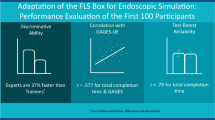Abstract
Introduction
This study assessed the utility of a checklist in troubleshooting endoscopic equipment. Prior studies have demonstrated that performance in simulated tasks translates into completion of similar tasks in the operating room. Checklists have been shown to decrease error and improve patient safety. There is currently limited experience with the use of simulation and checklists to improve troubleshooting of endoscopic equipment. We propose the use of a checklist during a simulated colonoscopy to improve performance during endoscopic troubleshooting.
Methods
This study randomized 20 surgical residents (PGY1–3) who were blinded to the purpose of the simulation. Participants were asked to complete two consecutive colonoscopies in a mock endoscopy suite. Prior to each trial, a standard set of equipment malfunctions were created; the equipment was returned to working order if the subjects were unable to successfully troubleshoot the equipment within the first 3 min of the simulation. Between trials, the intervention group was provided a troubleshooting checklist, which they were permitted to utilize during the second trial. The control group had no intervention. Scores were calculated for each task by subtracting time to completion from total time allowed (180 s), with 0 indicating the task was not completed. Groups were compared utilizing unpaired Student’s t-test with p < 0.05 threshold for significance.
Results
Average scores were compared for 5 tasks in the first trial and 6 tasks in the second trial. During the first trial, there were no significant differences. However, during the second trial, there was a significant improvement with the checklist for 5/6 tasks.
Conclusion
Use of a checklist, with no further intervention, significantly improves the ability of novice endoscopists to identify and remedy common equipment malfunctions. Introduction of a troubleshooting checklist may represent a simple and low-cost way to improve both efficiency and safety in the endoscopy suite.

Similar content being viewed by others
References
Accreditation Council for Graduate Medical Education. Surgery and pediatric surgery program requirements RRC. News for Surgery (2008) ACGME.org. Accessed 15 June 2012
Pearl JP, Marks JM (2006) The future of teaching surgical endoscopy. Surg Innov 13:280–282
Fried GM, Feldman LS, Vassiliou MC, Fraser SA, Stanbridge D, Ghitulescu G, Andrew CG (2004) Proving the value of simulation in laparoscopic surgery. Ann Surg 240:518–528
American College of Surgeons (ACS) Program for the Accreditation of Education Institutes. http://www.facs.org/education/accreditationprogram/index.html. Accessed 15 June 2012
Scott DJ, Dunnington GL (2008) The new ACS/APDS skills curriculum: moving the learning curve out of the operating room. J Gastrointest Surg 12:213–221
Verdaasdonk EGG, Stassen LPS, van der Elst M, Karsten TM, Dankelman J (2007) Problems with technical equipment during laparoscopic surgery: an observational study. Surg Endosc 21:275–279
Rodrigues SP, Wever AM, Dankelman J, Jansen FW (2012) Risk factors in patient safety: minimally invasive surgery versus conventional surgery. Surg Endosc 26:350–356
Scott DJ (2008) Laparoscopic troubleshooting module. In: Dunnington G (ed.) American College of Surgeons (ACS)/Association of Program Directors in Surgery (APDS) surgical skills curriculum for residents phase III. http://www.facs.org/education/surgicalskills.html. Accessed 15 June 2012
Arain NA, Hogg DC, Gala RB, Bhoja R, Tesfay ST, Webb EM, Scott DJ (2012) Construct and face validity of the American College of Surgeons/Association of Program Directors in Surgery laparoscopic troubleshooting team training exercise. Am J Surg 203:54–62
Powers KA, Rehrig ST, Irias N, Albano HA, Malinow A, Jones SB, Moorman DW, Pawlowski JB, Jones DB (2008) Simulated laparoscopic operating room crisis: an approach to enhance the surgical team performance. Surg Endosc 22:885–900
Verdaasdonk EG, Stassen LP, Hoffmann WF, van de Elst M, Dankleman J (2008) Can a structured checklist prevent problems with laparoscopic equipment? Surg Endosc 22(10):2238–2243
Buzink SN, van Lier L, de Hingh IHJT, Jakimowicz JJ (2010) Risk-sensitive events during laparoscopic cholecystectomy: the influence of the integrated operating room and a preoperative checklist tool. Surg Endosc 24:1990–1995
Olympus Evis Exera GIF/CF/PCF Type 160 series operation manual. http://www.wemed1.com/downloads/dl/file/id/7129/product/4802/manual_for_enfv_o_160.pdf. Accessed 10 Jan 2017
Author information
Authors and Affiliations
Corresponding author
Ethics declarations
Disclosures
Jenny Lam, B.S., Kevin Grimes, M.D., Adnan Mohsin, B.S., and Shawn Tsuda, M.D., F.A.C.S. have no conflicts of interest or financial ties to disclose.
Rights and permissions
About this article
Cite this article
Lam, J., Grimes, K., Mohsin, A. et al. Troubleshooting common endoscopic malfunctions: a study integrating a preoperative checklist and troubleshooting guide into surgical resident training. Surg Endosc 31, 4597–4602 (2017). https://doi.org/10.1007/s00464-017-5521-1
Received:
Accepted:
Published:
Issue Date:
DOI: https://doi.org/10.1007/s00464-017-5521-1




